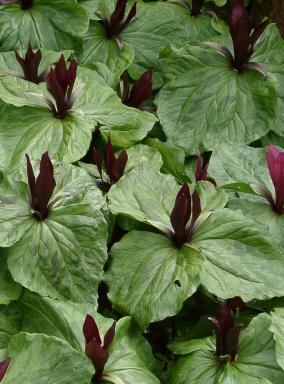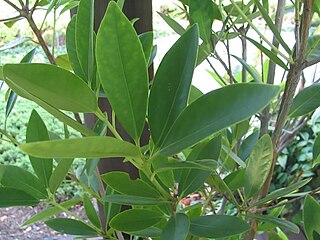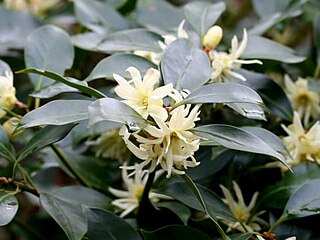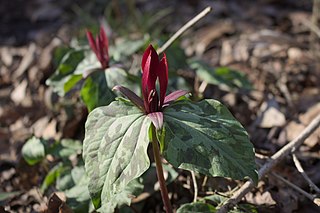
Trillium is a genus of about fifty flowering plant species in the family Melanthiaceae. Trillium species are native to temperate regions of North America and Asia, with the greatest diversity of species found in the southern Appalachian Mountains in the southeastern United States.

Trillium chloropetalum, also known as giant trillium, giant wakerobin, or common trillium, is a species of flowering plant in the family Melanthiaceae. It is endemic to the western U.S. state of California, being especially frequent in and around the San Francisco Bay Area.

Trillium erectum, the red trillium, also known as wake robin, purple trillium, bethroot, or stinking benjamin, is a species of flowering plant in the family Melanthiaceae. The plant takes its common name "wake robin" by analogy with the European robin, which has a red breast heralding spring. Likewise Trillium erectum is a spring ephemeral plant whose life-cycle is synchronized with that of the forests in which it lives. It is native to the eastern United States and eastern Canada from northern Georgia to Quebec and New Brunswick.

Illicium verum is a medium-sized evergreen tree native to South China and northeast Vietnam. Its star-shaped pericarps harvested just before ripening is a spice that closely resembles anise in flavor. Its primary production country is China, followed by Vietnam and other Southeast Asian countries. Star anise oil is a highly fragrant oil used in cooking, perfumery, soaps, toothpastes, mouthwashes, and skin creams. Until 2012, when they switched to using genetically modified E. coli, Roche Pharmaceuticals used up to 90% of the world's annual star anise crop to produce oseltamivir (Tamiflu) via shikimic acid.

Rubus parviflorus, the fruit of which is commonly called the thimbleberry or redcap, is a species of Rubus native to northern temperate regions of North America. The plant has large hairy leaves and no thorns. It bears edible red fruit similar in appearance to a raspberry, but shorter and almost hemispherical. It has not been commercially developed for the retail berry market, but is cultivated for landscapes.

Illicium anisatum, with common names Japanese star anise, Aniseed tree, and sacred Anise tree, known in Japanese as shikimi, is an evergreen shrub or small tree closely related to the Chinese star anise. Since it is highly toxic, the fruit is not edible; instead, the dried and powdered leaves are burned as incense in Japan. Its branches and evergreen leaves are considered highly sacred by Japanese Buddhists due to insects' aversion to them and their ability to remain fresh after pruning.

Illicium is a genus of flowering plants treated as part of the family Schisandraceae, or alternately as the sole genus of the Illiciaceae. It has a disjunct distribution, with most species native to eastern Asia and several in parts of North America, including the southeastern United States, Mexico, and the Caribbean. General common names include star anise and anisetree. The genus name comes from the Latin illicere.

Illiciaceae A.C.Sm. was a family of flowering plants recognized in a number of systems of plant taxonomy. The Illiciaceae is not recognized as a distinct family by the APG III system of plant taxonomy, the most well accepted system in use today.

Trillium luteum, the yellow trillium or yellow wakerobin, is a species of flowering plant in the bunchflower family Melanthiaceae. It is a member of the Trillium cuneatum complex, a closely related group of sessile-flowered trilliums. The species is endemic to the southeastern United States, especially in and around the Great Smoky Mountains of eastern Tennessee and western North Carolina.

Trillium cuneatum, the little sweet betsy, also known as whip-poor-will flower, large toadshade, purple toadshade, and bloody butcher, is a species of flowering plant in the family Melanthiaceae. It is a member of the Trillium cuneatum complex, a subgroup of the sessile-flowered trilliums. It is native to the southeastern United States but is especially common in a region that extends from southern Kentucky through central Tennessee to northern Alabama. In its native habitat, this perennial plant flowers from early March to late April. It is the largest of the eastern sessile-flowered trilliums.
Illicium ternstroemioides is a species of tree in the family Schisandraceae, or alternately, the Illiciaceae. It is native to northern Vietnam and Hainan Island in China.

Sabal palmetto, also known as cabbage palm, cabbage palmetto, sabal palm, blue palmetto, Carolina palmetto, common palmetto, Garfield's tree, and swamp cabbage, is one of 15 species of palmetto palm. It is native to the far Southeast United States, the Yucatán Peninsula in Mexico, the West Indies, and the Bahamas.

Illicium floridanum is an evergreen shrub native to the Gulf Coast area of the Southern United States, from Florida to Louisiana.

Trillium albidum is a species of flowering plant in the bunchflower family Melanthiaceae. It is the only trillium characterized by a stalkless white flower. The species is endemic to the western United States, ranging from central California through Oregon to southwestern Washington. In the San Francisco Bay Area, it is often confused with a white-flowered form of Trillium chloropetalum. In northern Oregon and southwestern Washington, it has a smaller, less conspicuous flower.

Sabal miamiensis, the Miami palmetto, is a rare plant species endemic to Dade County, Florida, in the vicinity of the city of Miami.
Illicium guajaibonense is a shrub endemic to Pinar del Rio in Western Cuba. It has only recently been recognized as a distinct species; previously it was considered to be subspecies of I. cubense. I. guajaibonense differs from I. cubense in flower color and other characters.

Trillium maculatum, the spotted wakerobin or spotted trillium, is a species of flowering plant in the family Melanthiaceae. It is a member of the Trillium cuneatum complex, a closely related group of sessile-flowered trilliums. The species is endemic to the southeastern United States, ranging across Alabama, Georgia, South Carolina, and northern Florida.
Trillium viride, commonly called the wood wakerobin, is a species of flowering plant in the family Melanthiaceae. It is found in the central United States, in certain parts of Missouri and Illinois. The specific epithet viride means "youthful" or "fresh-green", an apparent reference to the color of the plant's flower petals. For this reason, it is also called the green trillium, not to be confused with other green-flowered trilliums such as T. viridescens and the green form of T. sessile, both of which are found in Missouri.

Illicium henryi, also known by the common names Henry anise tree and Chinese anise tree is a species in the genus Illicium in the family Schisandraceae.

Symphyotrichum parviflorum is an annual and herbaceous plant commonly known as southwestern annual saltmarsh aster. It is native to Mexico, the Caribbean, most of Central America, Ecuador, and the southwestern United States. It is also known by the scientific name Symphyotrichum expansum.



















